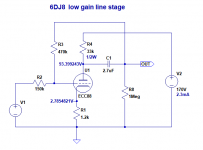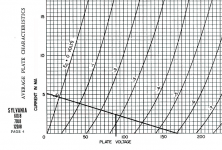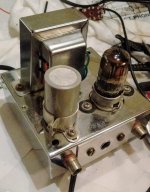Whatever its name is, it's a nice one to have in the toolkit. What else do you use if you need a tube (valve) stage with 3x gain?
Oh, and while I'm at it... 'Valve' is a much better name than 'tube'.... 😀
Oh, and while I'm at it... 'Valve' is a much better name than 'tube'.... 😀
I just whipped this up inside a little mono phono preamp chassis I had handy. I'd been meaning to try this. Forgive me if I call it an 'anode follower'. Force of habit, I guess.
I figure it's delivering only about 7dB of gain. I've found that a phono stage with about 48dB gain gives me playback levels similar to what comes from my digital sources. I have a Hagerman Bugle set up for about 42dB of gain, and I had to pin the volume control pretty high up to get only moderately loud levels. Another 6 or 7dB of gain should get that closer to the right spot, gain wise.
I tried it, and it works great. It added just a bit of sparkle or something to the sound from the Bugle (probably just more gain). LTspice predicts very low THD at typical line levels, into a 100k load. With the 6DJ8 biased to only 2.3mA plate current, it won't drive any kind of difficult loads. I might go back and try to improve it.
The experiment was successful, though. This is a good sounding circuit. It's also very quiet, despite a primitive psu made from a vintage multi-section electrolytic capacitor (already in the little chassis) plus an extra stage of decoupling and a plain old AC heater. I guess the NFB keeps the noise down.
That was fun.
I figure it's delivering only about 7dB of gain. I've found that a phono stage with about 48dB gain gives me playback levels similar to what comes from my digital sources. I have a Hagerman Bugle set up for about 42dB of gain, and I had to pin the volume control pretty high up to get only moderately loud levels. Another 6 or 7dB of gain should get that closer to the right spot, gain wise.
I tried it, and it works great. It added just a bit of sparkle or something to the sound from the Bugle (probably just more gain). LTspice predicts very low THD at typical line levels, into a 100k load. With the 6DJ8 biased to only 2.3mA plate current, it won't drive any kind of difficult loads. I might go back and try to improve it.
The experiment was successful, though. This is a good sounding circuit. It's also very quiet, despite a primitive psu made from a vintage multi-section electrolytic capacitor (already in the little chassis) plus an extra stage of decoupling and a plain old AC heater. I guess the NFB keeps the noise down.
That was fun.
Attachments
Last edited:
I haven't tried to look at this anode follower/shunt feedback stage (which I'll call the "Little Monster") on a scope yet, but I gave it a listen in my headphones setup. Listening in headphones lends itself to noticing tiny differences, so I thought this would be a good test. That setup is tough for tube stages because it has a 10k ohm volume control at the input (it's fed by a Raspberry Pi with DAC, which is designed to be loaded by such things).
I put the Little Monster after the DAC and before the headphone amp, so the Little Monster sees a 10k load. I could hear the 6dB of gain, so that works. I could also hear a slight 'clouding' of the sound compared to the setup without the Little Monster. I think the high-ish output impedance (predicted to be about 4k ohms) and weenie 2.5mA of plate current isn't enough to drive the load + feedback loop cleanly. But it didn't sound bad either. Just the tiniest bit different.
Encouraging that it survived this torture test.
I put the Little Monster after the DAC and before the headphone amp, so the Little Monster sees a 10k load. I could hear the 6dB of gain, so that works. I could also hear a slight 'clouding' of the sound compared to the setup without the Little Monster. I think the high-ish output impedance (predicted to be about 4k ohms) and weenie 2.5mA of plate current isn't enough to drive the load + feedback loop cleanly. But it didn't sound bad either. Just the tiniest bit different.
Encouraging that it survived this torture test.


